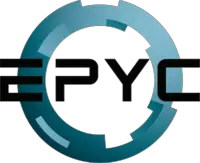(→7000 Series) |
(→7000 Series) |
||
| Line 38: | Line 38: | ||
* All models support everything up to {{x86||AVX2}} (i.e., {{x86|SMM}}, {{x86|FPU}}, {{x86|NX}}, {{x86|MMX}}, {{x86|SSE}}, {{x86|SSE2}}, {{x86|SSE3}}, {{x86|SSSE3}}, {{x86|SSE4.1}}, {{x86|SSE4.2}}, {{x86|AES}}, {{x86|AVX}}, {{x86|FMA3}}, and {{x86|AVX2}}), and {{x86|SHA}} | * All models support everything up to {{x86||AVX2}} (i.e., {{x86|SMM}}, {{x86|FPU}}, {{x86|NX}}, {{x86|MMX}}, {{x86|SSE}}, {{x86|SSE2}}, {{x86|SSE3}}, {{x86|SSSE3}}, {{x86|SSE4.1}}, {{x86|SSE4.2}}, {{x86|AES}}, {{x86|AVX}}, {{x86|FMA3}}, and {{x86|AVX2}}), and {{x86|SHA}} | ||
| + | |||
| + | It should be noted that for some models, there are two [[TDP]] values given because the TDP will depend on the memory rate used for the system (i.e., either 2666 MT/s or 2400 MT/s). | ||
<!-- NOTE: | <!-- NOTE: | ||
| Line 49: | Line 51: | ||
<table class="comptable sortable tc12 tc13"> | <table class="comptable sortable tc12 tc13"> | ||
<tr class="comptable-header"><th> </th><th colspan="12">List of Zen-based EPYC Processors</th></tr> | <tr class="comptable-header"><th> </th><th colspan="12">List of Zen-based EPYC Processors</th></tr> | ||
| − | <tr class="comptable-header"><th> </th><th colspan=" | + | <tr class="comptable-header"><th> </th><th colspan="6">Main Specs</th><th colspan="7">Frequency</th></tr> |
| − | + | <tr class="comptable-header"><th>Model<br> </th><th>Price</th><th>Launched</th><th>Cores</th><th>Threads</th><th>TDP</th><th>Memory</th><th>Base Frequency</th><th>Turbo Frequency<br><small>(up to 12 active cores)</small></th><th>Turbo Frequency<br><small>(All active cores)</small></th></tr> | |
<tr class="comptable-header comptable-header-sep"><th> </th><th colspan="25">[[Uniprocessors]]</th></tr> | <tr class="comptable-header comptable-header-sep"><th> </th><th colspan="25">[[Uniprocessors]]</th></tr> | ||
{{#ask: [[Category:microprocessor models by amd]] [[instance of::microprocessor]] [[microprocessor family::EPYC]] [[core name::Naples]] [[max cpu count:: 1]] | {{#ask: [[Category:microprocessor models by amd]] [[instance of::microprocessor]] [[microprocessor family::EPYC]] [[core name::Naples]] [[max cpu count:: 1]] | ||
| Line 59: | Line 61: | ||
|?core count | |?core count | ||
|?thread count | |?thread count | ||
| + | |?tdp | ||
| + | |?supported memory type | ||
|?base frequency#GHz | |?base frequency#GHz | ||
|?turbo frequency (1 core)#GHz | |?turbo frequency (1 core)#GHz | ||
| − | |? | + | |?turbo frequency (12 cores)#GHz |
| − | |? | + | |?turbo frequency (13 cores)#GHz |
|format=template | |format=template | ||
|template=proc table 3 | |template=proc table 3 | ||
| − | |userparam= | + | |userparam=11 |
|mainlabel=- | |mainlabel=- | ||
|valuesep=, | |valuesep=, | ||
| Line 77: | Line 81: | ||
|?core count | |?core count | ||
|?thread count | |?thread count | ||
| + | |?tdp | ||
| + | |?supported memory type | ||
|?base frequency#GHz | |?base frequency#GHz | ||
|?turbo frequency (1 core)#GHz | |?turbo frequency (1 core)#GHz | ||
| − | |? | + | |?turbo frequency (12 cores)#GHz |
| − | |? | + | |?turbo frequency (13 cores)#GHz |
|format=template | |format=template | ||
|template=proc table 3 | |template=proc table 3 | ||
| − | |userparam= | + | |userparam=11 |
|mainlabel=- | |mainlabel=- | ||
|valuesep=, | |valuesep=, | ||
Revision as of 00:29, 21 June 2017
| AMD EPYC | |

| |
| EPYC logo | |
| Developer | AMD |
| Manufacturer | GlobalFoundries |
| Type | System on chips |
| Introduction | May 16, 2017 (announced) June 20, 2017 (launch) |
| Architecture | High-performance Server SOCs |
| ISA | x86-64 |
| µarch | Zen |
| Word size | 64 bit 8 octets
16 nibbles |
| Process | 14 nm 0.014 μm
1.4e-5 mm |
| Technology | CMOS |
| Package | FCLGA-4094 |
| Socket | Socket SP3 |
| Succession | |
| ← | |
| Opteron | |
EPYC (pronounced epic) is a family of 64-bit x86 high-performance server multiprocessors introduced by AMD in 2017 as the successor to the Opteron family.
Contents
Overview
The EPYC family was announced during AMD's Financial Analyst Day on May 16, 2017. EPYC replaces the previous Opteron server family with the introduction of the Zen microarchitecture which was introduced in early in 2017 for the mainstream market. EPYC processors support 1-way and 2-way multiprocessing. The first series of processors based on the Naples codename was launched in June 2017.
Members
7000 Series
Introduced in June of 2017, first generation EPYC processors are based on the Zen architecture fabricated on GlobalFoundries' 14 nm process. EPYC 7000 series effectively succeeds the previous Opteron 6000 series. All models consist of four Zeppelin dies, providing support for up to octa-channel DDR4 ECC memory of up to 2400-2666 MT/s supporting up to 2 TiB of memory per socket (for up to 4 TiB in 2-way MP). Each processor has 128 PCIe lanes and non-P models also support two-way multiprocessing utilizing 64 PCIe lanes for this purpose from each CPU.
- All models support everything up to AVX2 (i.e., SMM, FPU, NX, MMX, SSE, SSE2, SSE3, SSSE3, SSE4.1, SSE4.2, AES, AVX, FMA3, and AVX2), and SHA
It should be noted that for some models, there are two TDP values given because the TDP will depend on the memory rate used for the system (i.e., either 2666 MT/s or 2400 MT/s).
| List of Zen-based EPYC Processors | |||||||||||||||||||||||||
|---|---|---|---|---|---|---|---|---|---|---|---|---|---|---|---|---|---|---|---|---|---|---|---|---|---|
| Main Specs | Frequency | ||||||||||||||||||||||||
| Model | Price | Launched | Cores | Threads | TDP | Memory | Base Frequency | Turbo Frequency (up to 12 active cores) | Turbo Frequency (All active cores) | ||||||||||||||||
| Uniprocessors | |||||||||||||||||||||||||
| 7351P | $ 750.00 € 675.00 £ 607.50 ¥ 77,497.50 | 20 June 2017 | 16 | 32 | 155 W 155,000 mW , 170 W0.208 hp 0.155 kW 170,000 mW 0.228 hp 0.17 kW | DDR4-2666, DDR4-2400 | 2.4 GHz 2,400 MHz 2,400,000 kHz | 2.9 GHz 2,900 MHz 2,900,000 kHz | 2.9 GHz 2,900 MHz 2,900,000 kHz | ||||||||||||||||
| 7401P | $ 1,075.00 € 967.50 £ 870.75 ¥ 111,079.75 | 20 June 2017 | 24 | 48 | 155 W 155,000 mW , 170 W0.208 hp 0.155 kW 170,000 mW 0.228 hp 0.17 kW | DDR4-2666, DDR4-2400 | 2 GHz 2,000 MHz 2,000,000 kHz | 3 GHz 3,000 MHz 3,000,000 kHz | 3 GHz 3,000 MHz 3,000,000 kHz | ||||||||||||||||
| 7551P | $ 2,100.00 € 1,890.00 £ 1,701.00 ¥ 216,993.00 | 20 June 2017 | 32 | 64 | 180 W 180,000 mW 0.241 hp 0.18 kW | DDR4-2666 | 2 GHz 2,000 MHz 2,000,000 kHz | 3 GHz 3,000 MHz 3,000,000 kHz | 3 GHz 3,000 MHz 3,000,000 kHz | ||||||||||||||||
| Multiprocessors (dual-socket) | |||||||||||||||||||||||||
| 7251 | $ 574.00 € 516.60 £ 464.94 ¥ 59,311.42 | 20 June 2017 | 8 | 16 | 120 W 120,000 mW 0.161 hp 0.12 kW | DDR4-2400 | 2.1 GHz 2,100 MHz 2,100,000 kHz | 2.9 GHz 2,900 MHz 2,900,000 kHz | |||||||||||||||||
| 7261 | 14 June 2018 | 8 | 16 | 155 W 155,000 mW , 170 W0.208 hp 0.155 kW 170,000 mW 0.228 hp 0.17 kW | DDR4-2666, DDR4-2400 | 2.5 GHz 2,500 MHz 2,500,000 kHz | 2.9 GHz 2,900 MHz 2,900,000 kHz | ||||||||||||||||||
| 7281 | $ 650.00 € 585.00 £ 526.50 ¥ 67,164.50 | 20 June 2017 | 16 | 32 | 155 W 155,000 mW , 170 W0.208 hp 0.155 kW 170,000 mW 0.228 hp 0.17 kW | DDR4-2666, DDR4-2400 | 2.1 GHz 2,100 MHz 2,100,000 kHz | 2.7 GHz 2,700 MHz 2,700,000 kHz | 2.7 GHz 2,700 MHz 2,700,000 kHz | ||||||||||||||||
| 7301 | $ 825.00 € 742.50 £ 668.25 ¥ 85,247.25 | 20 June 2017 | 16 | 32 | 155 W 155,000 mW , 170 W0.208 hp 0.155 kW 170,000 mW 0.228 hp 0.17 kW | DDR4-2666, DDR4-2400 | 2.2 GHz 2,200 MHz 2,200,000 kHz | 2.7 GHz 2,700 MHz 2,700,000 kHz | 2.7 GHz 2,700 MHz 2,700,000 kHz | ||||||||||||||||
| 7351 | $ 1,100.00 € 990.00 £ 891.00 ¥ 113,663.00 | 20 June 2017 | 16 | 32 | 155 W 155,000 mW , 170 W0.208 hp 0.155 kW 170,000 mW 0.228 hp 0.17 kW | DDR4-2666, DDR4-2400 | 2.4 GHz 2,400 MHz 2,400,000 kHz | 2.9 GHz 2,900 MHz 2,900,000 kHz | 2.9 GHz 2,900 MHz 2,900,000 kHz | ||||||||||||||||
| 7371 | $ 1,550.00 € 1,395.00 £ 1,255.50 ¥ 160,161.50 | 2019 | 16 | 32 | 200 W 200,000 mW 0.268 hp 0.2 kW | DDR4-2666, DDR4-2400 | 3.1 GHz 3,100 MHz 3,100,000 kHz | 3.8 GHz 3,800 MHz 3,800,000 kHz | 3.6 GHz 3,600 MHz 3,600,000 kHz | ||||||||||||||||
| 7401 | $ 1,850.00 € 1,665.00 £ 1,498.50 ¥ 191,160.50 | 20 June 2017 | 24 | 48 | 155 W 155,000 mW , 170 W0.208 hp 0.155 kW 170,000 mW 0.228 hp 0.17 kW | DDR4-2666, DDR4-2400 | 2 GHz 2,000 MHz 2,000,000 kHz | 3 GHz 3,000 MHz 3,000,000 kHz | 3 GHz 3,000 MHz 3,000,000 kHz | ||||||||||||||||
| 7451 | $ 2,400.00 € 2,160.00 £ 1,944.00 ¥ 247,992.00 | 20 June 2017 | 24 | 48 | 180 W 180,000 mW 0.241 hp 0.18 kW | DDR4-2666 | 2.3 GHz 2,300 MHz 2,300,000 kHz | 3.2 GHz 3,200 MHz 3,200,000 kHz | 3.2 GHz 3,200 MHz 3,200,000 kHz | ||||||||||||||||
| 7501 | $ 3,400.00 € 3,060.00 £ 2,754.00 ¥ 351,322.00 | 20 June 2017 | 32 | 64 | 155 W 155,000 mW , 170 W0.208 hp 0.155 kW 170,000 mW 0.228 hp 0.17 kW | DDR4-2666, DDR4-2400 | 2 GHz 2,000 MHz 2,000,000 kHz | 3 GHz 3,000 MHz 3,000,000 kHz | 3 GHz 3,000 MHz 3,000,000 kHz | ||||||||||||||||
| 7551 | $ 3,400.00 € 3,060.00 £ 2,754.00 ¥ 351,322.00 | 20 June 2017 | 32 | 64 | 180 W 180,000 mW 0.241 hp 0.18 kW | DDR4-2666 | 2 GHz 2,000 MHz 2,000,000 kHz | 3 GHz 3,000 MHz 3,000,000 kHz | 3 GHz 3,000 MHz 3,000,000 kHz | ||||||||||||||||
| 7601 | $ 4,200.00 € 3,780.00 £ 3,402.00 ¥ 433,986.00 | 20 June 2017 | 32 | 64 | 180 W 180,000 mW 0.241 hp 0.18 kW | DDR4-2666 | 2.2 GHz 2,200 MHz 2,200,000 kHz | 3.2 GHz 3,200 MHz 3,200,000 kHz | 3.2 GHz 3,200 MHz 3,200,000 kHz | ||||||||||||||||
| Count: 14 | |||||||||||||||||||||||||
See also
- Intel
| designer | AMD + |
| first announced | May 16, 2017 + |
| first launched | June 20, 2017 + |
| full page name | amd/epyc + |
| instance of | system on a chip family + |
| instruction set architecture | x86-64 + |
| main designer | AMD + |
| manufacturer | GlobalFoundries + |
| microarchitecture | Zen + |
| name | AMD EPYC + |
| package | FCLGA-4094 + |
| process | 14 nm (0.014 μm, 1.4e-5 mm) + |
| socket | Socket SP3 + |
| technology | CMOS + |
| word size | 64 bit (8 octets, 16 nibbles) + |
